Sacred And Profane Expansion
Monsters
- Lilit’s Omen

An overview of available Monsters cards shows that the only archetype which could make consistent use of Lilit’s Omen is Deathwish (Caranthir: The Golden Child or Mammuna are singular exceptions, not having enough support in their archetypes). Then Overwhelming Hunger or order units setup could deny rupture tax with immediate consume. Moreover, giving Doomed, this card couldn’t be used to summon Dettlaff: Higher Vampire, or even Ruehin.
The card is decent value, but requires consumes (if played in DW), while enough number of efficient consumes is the bottleneck of Deathwish decks already. This card wouldn’t improve Monsters position in factions hierarchy.
- Dagon

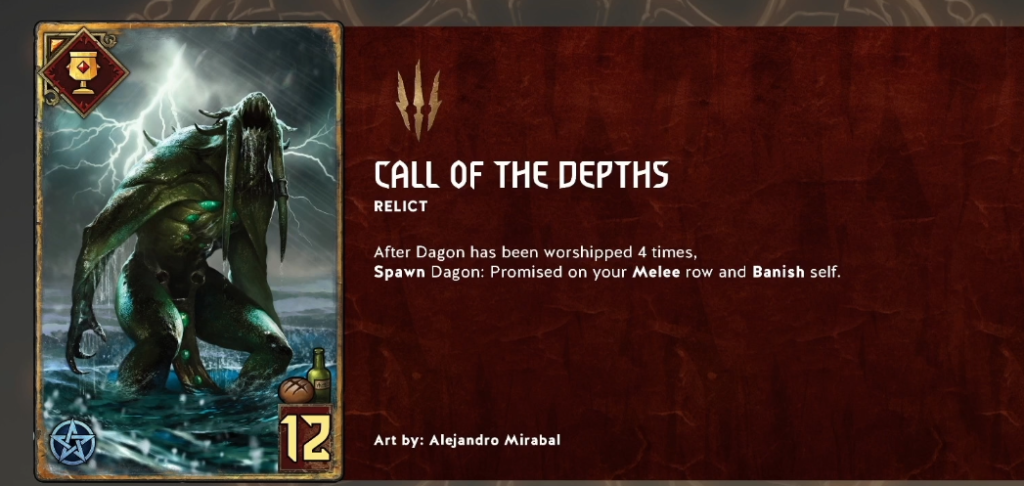
Played in R1/R2, Dagon: Promised is an interesting carryover card for Deathwish archetype, additionally supporting consume (Dagon could consume once when played and then another time when summoned). 1st form Dagon also neatly circumvents Heatwave thanks to Call of the Depths. Ceiling carryover value is 20+ points, while graveyard hate could deny more than half of it.

It is worth noting that Monsters got the only evolving card possibly trading down to Heatwave in the final form. Solid 8 tempo play, requiring OH charge in already stretched with respect to consumes Deathwish archetype to play around Heatwave at least a bit.
Dagon is a good card overall and has outstanding ceiling (mostly thanks to counter 5 duplication ability), but is very slow and prone to locks/hard removal in comparison with cards like Tyr, Dana or Svalblod.
Nilfgaard
- Ard Feiann

Ard Feiann is summoned from the deck after gold Aristocrat gets deployed. It means thinning and reduction of bricking risk (most importantly of Ard Feiann itself). Moreover, the deck manipulation order ability of this location could greatly improve further draws in the game. Therefore, a bunch of R1 playable gold artistocrat looks like good packet to go with Ard Feiann.
On the other hand, the draws improvement effect is short legged. Every order use is a risk of being forced to place good card at the bottom, and the more order is used, the higher the risk.
Card is pretty good overall; effect could be compared with Roach or King of Beggars. It would definitiely be a trump in synergistic Nilfgaard decks based on Artistocrats. Bleeding procs Thirsty Dames, Spying enables Artaud Terranova and Coup De Grace, while also possibly procing Usurper Emperor.
- Torres Var Emreis

Deploy effect could add value to own deck, but clogs it at the same time. Artaud becomes instantly enabled, while Coup also gains some setup. Finally, boost could reach up to 3*6 = 18 points, which means a threat of 22 points tempo play. Ininite reach on red coin with a drawback of clogging the deck. Strong card overall, exact power is a bit meta dependent.
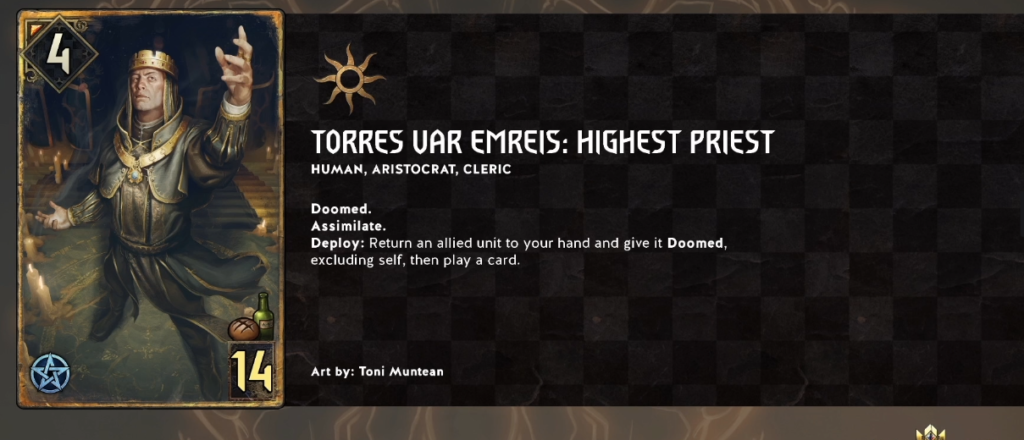
Assimilate is an engine tag, worth more than 1 point per turn; in fact Stefan Skellen with 12 Tactics could proc Assimilate 4 times for example.
Torres var Emreis: Highest Priest deploy in its essence means replaying a card. Strong deploy cards are the most convenient targets: Torres would then play as 4+Assimilate+value of repeated deploy ability.
Examples of simple Torres targets are Artaud Terranova or Stefan Skellen. Evolved Torres is not outstanding for current powercreep standards.
Northern Realms
- Temple Of Melitele

Heavily RNG dependent card. Creating legendary cards varies between clogging the deck with additional 3 useless cards and getting amazing, synergistic golds, playing +10 points above bronze level. The carryover spans from negative to potentially ~+30 then.
Unbalanced card, playing above the curve on average, but not consistently broken. Boost could be combined with cards like Prince Anseis. Temple is usually supposed to be played as the first card in the round to immediately activate the order effect for highest buff.

The second form especially invites usage on strong deploy / order cards. Probably plays below power vs provision curve outside synergistic decks; removal effect is not convenient enough.
- Melitele

A puzzling card, requiring very rigid archetype, completely focused on drawing and shuffling back cards. The card itself has pretty high ceiling, but also severe requirements and obligations; also competes with Travelling Priestess for shuffle-back value.
Not a game-changer.
Skellige
- Svalblod

Strong card, double punishing swarm decks. Even assuming that both sides have equal number of vanilla units (no payoff from damage), Svalblod plays as instant 15 for 13, returning provision cost. Each card benefiting from damage, or each unit more on opponent’s side of the board, gives ~+2 to instant Svalblod value.
The passive ability of generating Fanatics is equivalent to ~+5 per turn engine. Unbalanced card.
- Tyr
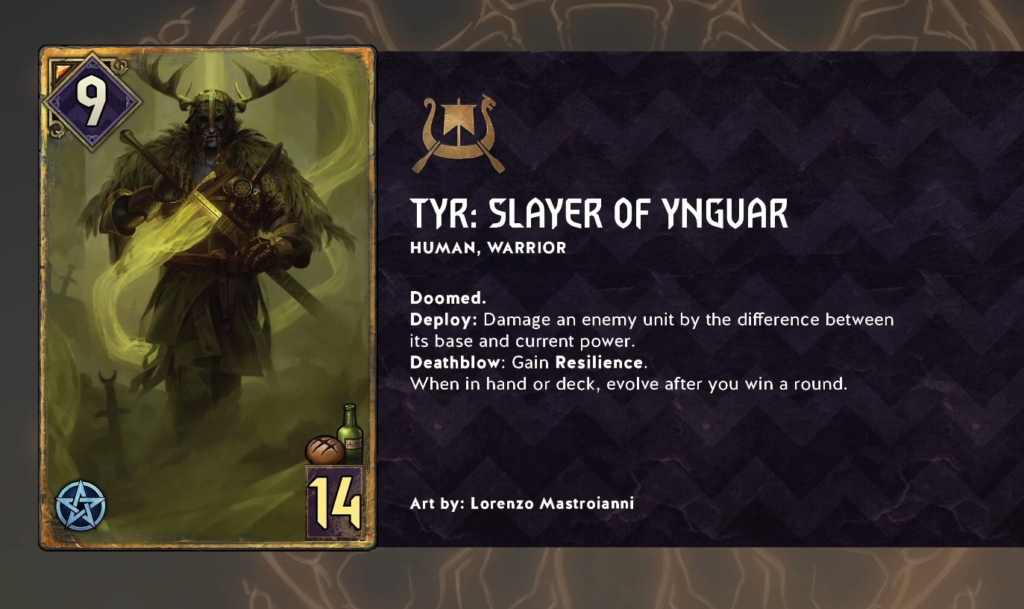
Tyr effect could be used as a reset (‘green punish’) – a 3 points stronger, but overcosted alternative for Morkvarg – or with damage setup, as Resilience card, offering decent tempo at the same time. Flexibility is definitely a perk and skillful part of this Warrior.
Good card, but not broken in this form. Compared with other Resilience cards: Shupe: Knight or Ciri:Nova, the card is at comparable power vs provision level.

Evolved Tyr effect is very strong. Assuming that a Tuirseach Invader is accessible in the graveyard at 8 points, Tyr boosts it to 16 points and plays as 17 for 14 instant. Then there is additionally Discard effect – improving hand quality or discarding a Skirmisher could elevate instant value to ~20.
Moreover, Tyr is a hyperfast engine, requiring immediate answer. It plays roughly +5 points per turn, possibly around 40 points overall. Unbalanced card.
Scoia'tael
- Quarixis

The effect has great potential, but initial tempo is very weak and prone to control, unless accompanied with Call of Harmony leader (Dana Meadbh). Convergence value itself could be assessed as around 7 points, which means that first proc roughly evens out value and provision. Then each next Relict brings another ~+8 (+1 thanks to Harmony). Not many good Relicts are accessible though to accompany Quarixis.
One dirty trick possible is playing Quarixis via Ihuarraquax to get out strong opponent’s gold and instantly proc Quarixis from Quax (Relict) at the same time.
- Dana Méadbh

Harmony tag is supposed to grow Dana power to about her provision cost (14 points) in the long round. That’s because in the current (Gwent 10.12) game state Harmony is about +0.8 per turn engine tag with even better ceiling thanks to Chameleons. Outside the main effect then, the card power is comparable with Eskel:Pathfinder.
The main effect handbuffs all Scoia’tael units with categories not present on the board. As the effect is resolved at the end of the turn, even when opponent passes on 7 cards, 4 turns of handbuff will go through. Let’s estimate the ceiling in such scenario: 9+8+7+7 = 31 points of carryover (neglecting value of Dana herself). Unbalanced card requiring immediate retort, highly variant with respect to Round 1 draws from both sides. Autoinclude in units based Scoia’tael decks with multiple categories. Payoff is too strong to make any other kind of Scoia’tael decks playable, unless those are control builds answering Dana (and other Sacred and Profane stamps) immediately in an efficient way.

A casual 25+ for 14 card supporting mostly Scoia’tael engine decks with varied unit categories. Could be played early for protection, or late as payoff if strong engines openers are safe. The latter option is the most common.
Syndicate
- Count Reuven’s Treasure

The create crime part is very random – there is a decent chance of playing crime for 3 points with full bank, or a roll of three profit cards (for example Line of Credit+Eavesdrop+Swindle) may happen as well.
The initial value of this card in a full Crime deck could be assessed as 11+6 = 17 for 12; on power vs provision curve.
The main point of interest is the passive ability. This one is a nice joke on old Dijkstra leader ability, where getting extra leader charge from every played crime was possible. The most interesting point of Count Reuven’s Treasure is carryover value. It’s a bit tricky; Treasure will remain on the board only for the next round. Therefore The Flying Redanian looks like great addition to Treasure; it could be played on drypass then and overall, losing more than one coin due to overprofit is impossible with spender and this card on the board.
Another card with good Count Reuven’s Treasure synergy is Townsfolk, who get proced twice thanks to counter carryover.
Good potential, but nothing broken in comparison with other Sacred and Profane cards.
- Saint Gregory
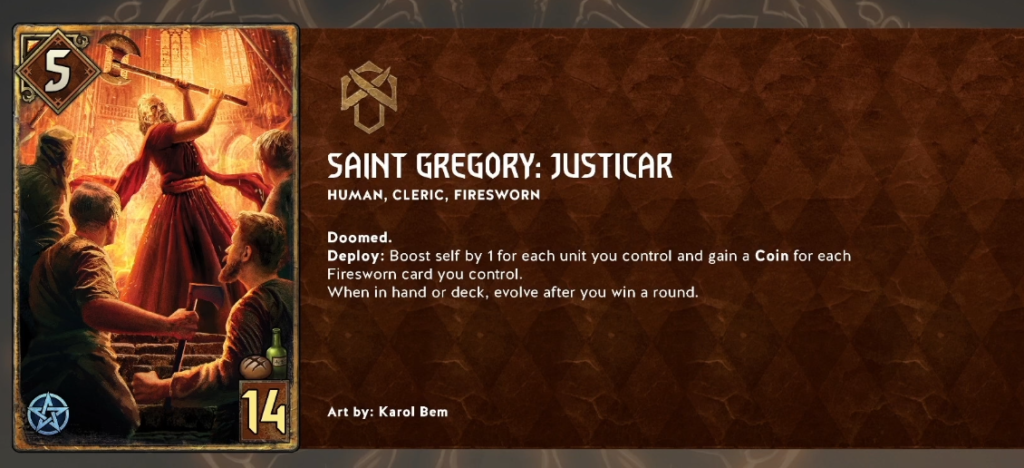
Important thing to note – Saint Gregory counts himself in all abilities; gains extra coin and extra buff from self. The ceiling of the first form is 5+9+18=32 for 14. Out of those points though, 23 are located on Gregory himself – the card plays into tall removal, and there may be few similar targets in the swarm (sidenote: even bigger Gregory is possible with Jackpot leader – nice feed for memes)
Gregory in the first form could be interesting to threat reach on red coin. He could also be a Damnation target – in such case 10 power unit on the board is required, and Damnation could reach 22 for 6 peak.
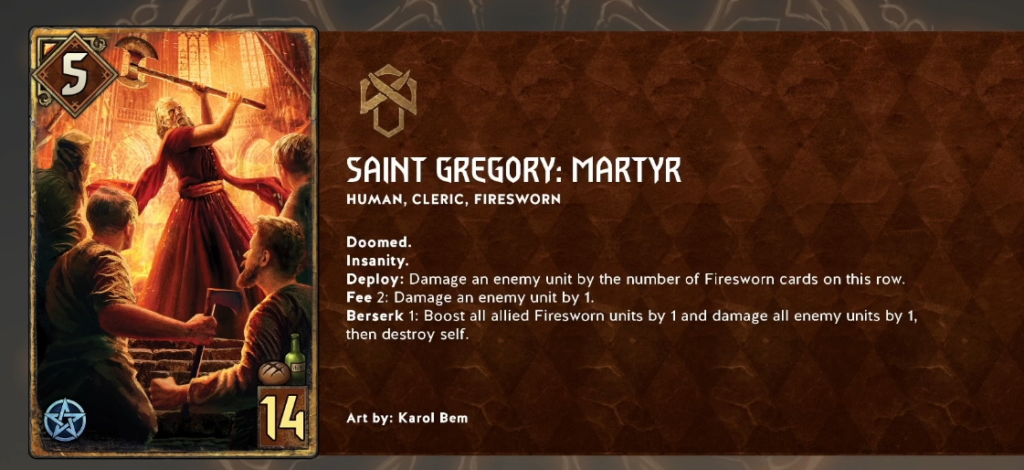
While ceiling of 9+2+17+18 = 46 may look impressive, Gregory requires some setup and may struggle to control main opponent’s threats in time, especially with second say. Good card, providing some control to Firesworn archetype (and maybe beyond as well – Jacques, Hemmelfart and good Firesworn bronzes may be enough to get acceptable Gregory value).
Sadly, Firesworn gets hardly and singlehandedly countered by Svalblod.
Summary & Predictions
- Critics
The Sacred And Profane drop consists of 12 high-end golden cards, supporting particular archetypes. It is the concluding expansion of 2022 year in Gwent: The Witcher Card Game and brings characteristic trends of preceeding expansions to next level.
With limited number of new cards, insist is put on most of them having powerful, game winning effects. Consequently, many of new cards have ceiling of 40 points and above if not countered, usually without going tall. What used to be reserved for strongest Scenario cards, now is achieved by new units, usually with better tempo.
Expansion then is supposed to be fun and fresh as much as possible with 12 cards, while going in exact reverse direction to competitive / long-term playability problems and feedback. Due to power being tens of points above current power vs provision curve, the point gap between new/old and bronze/gold becomes deeper. This along with 2-forms mechanics, makes the game more draw dependent. Whenever 2nd form is significantly stronger than 1st, whoever wins Round 1 may get good chance for brute force 2:0.
I hope that every expansion now comes along with two variants of cards – one unbalanced for release and second one, with reasonable stats, for next patch nerf 😉 The problem is not only in raw power, but in binarities created by unbalanced cards. Missing answers in time, or drawing worse, means not losing 10 points of bronze-to-gold gap, but something closer to ~50 points if the new card reaches its ceiling value.
Outside mentioned issues, an annoying part designwise is Svalblod’s ability to single-handedly destroy swarm. It could be compared with Renfri and Curse of Envy in the release state. Yes, Svalblod is factional, but instant destruction of one of main archetypes is nothing healthy. Card like Lacerate, Lambert: Swordmaster or Wild Boar Of The Sea play below the curve when missing swarm matchup or long enough round. Svalblod is always on top and destroys swarm more than tech cards (compare with Yennefer of Vengerberg put into a random no-unit deck as anti-swarm tech… Svalblod is still few times more threatening and does better points).
- Predictions
Skellige, Nilfgaard and Scoia’tael would be top factions in the Decemeber Season. Skellige and Scoia’tael thanks to powerful, unbalanced cards: Tyr, Dana, Svalblod. Nilfgaard due to best control tools directed against new cards, as well as possibility of playing opponent’s deck against themselves.
You could check out data on GwentData or here on Pro Ladder tab to validate this prediction.
I predict that there would be no spectacular differences in winrates favoring one faction, but some unpleasance hidden in everyday’s gameplay due to binarities and draw dependence, especially on early stages of the game. Will o’ the wisp suddenly seeing play as an instant removal tech against new cards is alarming enough by itself.

